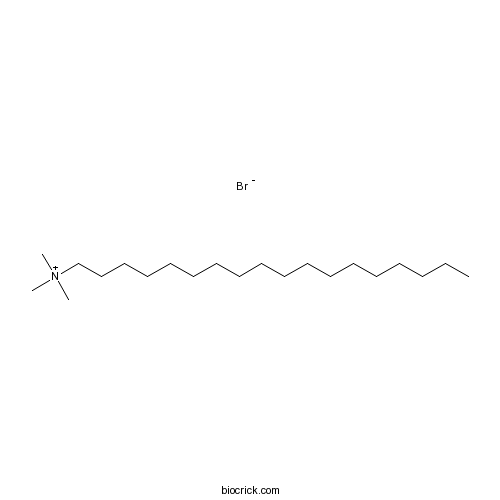OctMABCAS# 1120-02-1 |

- GW4064
Catalog No.:BCC4500
CAS No.:278779-30-9
- Chenodeoxycholic acid
Catalog No.:BCN2620
CAS No.:474-25-9
- XL335
Catalog No.:BCC4501
CAS No.:629664-81-9
Quality Control & MSDS
3D structure
Package In Stock
Number of papers citing our products

| Cas No. | 1120-02-1 | SDF | Download SDF |
| PubChem ID | 70708 | Appearance | Powder |
| Formula | C21H46BrN | M.Wt | 392.5 |
| Type of Compound | N/A | Storage | Desiccate at -20°C |
| Solubility | Limited solubility | ||
| Chemical Name | trimethyl(octadecyl)azanium;bromide | ||
| SMILES | CCCCCCCCCCCCCCCCCC[N+](C)(C)C.[Br-] | ||
| Standard InChIKey | SZEMGTQCPRNXEG-UHFFFAOYSA-M | ||
| Standard InChI | InChI=1S/C21H46N.BrH/c1-5-6-7-8-9-10-11-12-13-14-15-16-17-18-19-20-21-22(2,3)4;/h5-21H2,1-4H3;1H/q+1;/p-1 | ||
| General tips | For obtaining a higher solubility , please warm the tube at 37 ℃ and shake it in the ultrasonic bath for a while.Stock solution can be stored below -20℃ for several months. We recommend that you prepare and use the solution on the same day. However, if the test schedule requires, the stock solutions can be prepared in advance, and the stock solution must be sealed and stored below -20℃. In general, the stock solution can be kept for several months. Before use, we recommend that you leave the vial at room temperature for at least an hour before opening it. |
||
| About Packaging | 1. The packaging of the product may be reversed during transportation, cause the high purity compounds to adhere to the neck or cap of the vial.Take the vail out of its packaging and shake gently until the compounds fall to the bottom of the vial. 2. For liquid products, please centrifuge at 500xg to gather the liquid to the bottom of the vial. 3. Try to avoid loss or contamination during the experiment. |
||
| Shipping Condition | Packaging according to customer requirements(5mg, 10mg, 20mg and more). Ship via FedEx, DHL, UPS, EMS or other couriers with RT, or blue ice upon request. | ||
| Description | Dynamin inhibitor (IC50 = 1.9 μM for dynamin I). Inhibits receptor-mediated endocytosis (IC50 = 16 μM). Displays similar activity to MitMAB . |

OctMAB Dilution Calculator

OctMAB Molarity Calculator
| 1 mg | 5 mg | 10 mg | 20 mg | 25 mg | |
| 1 mM | 2.5478 mL | 12.7389 mL | 25.4777 mL | 50.9554 mL | 63.6943 mL |
| 5 mM | 0.5096 mL | 2.5478 mL | 5.0955 mL | 10.1911 mL | 12.7389 mL |
| 10 mM | 0.2548 mL | 1.2739 mL | 2.5478 mL | 5.0955 mL | 6.3694 mL |
| 50 mM | 0.051 mL | 0.2548 mL | 0.5096 mL | 1.0191 mL | 1.2739 mL |
| 100 mM | 0.0255 mL | 0.1274 mL | 0.2548 mL | 0.5096 mL | 0.6369 mL |
| * Note: If you are in the process of experiment, it's necessary to make the dilution ratios of the samples. The dilution data above is only for reference. Normally, it's can get a better solubility within lower of Concentrations. | |||||

Calcutta University

University of Minnesota

University of Maryland School of Medicine

University of Illinois at Chicago

The Ohio State University

University of Zurich

Harvard University

Colorado State University

Auburn University

Yale University

Worcester Polytechnic Institute

Washington State University

Stanford University

University of Leipzig

Universidade da Beira Interior

The Institute of Cancer Research

Heidelberg University

University of Amsterdam

University of Auckland

TsingHua University

The University of Michigan

Miami University

DRURY University

Jilin University

Fudan University

Wuhan University

Sun Yat-sen University

Universite de Paris

Deemed University

Auckland University

The University of Tokyo

Korea University
- Docosanoic acid
Catalog No.:BCC8952
CAS No.:112-85-6
- Oleic acid
Catalog No.:BCN7159
CAS No.:112-80-1
- Methyl linoleate
Catalog No.:BCN8137
CAS No.:112-63-0
- Methyl Oleate
Catalog No.:BCN8306
CAS No.:112-62-9
- Methyl Stearate
Catalog No.:BCN8309
CAS No.:112-61-8
- Methyl hexadecanoate
Catalog No.:BCN8290
CAS No.:112-39-0
- Acetic acid octyl ester
Catalog No.:BCN8303
CAS No.:112-14-1
- 2-Undecanone
Catalog No.:BCN8461
CAS No.:112-12-9
- Quetiapine fumarate
Catalog No.:BCN5339
CAS No.:111974-72-2
- Quetiapine
Catalog No.:BCC1877
CAS No.:111974-69-7
- Adenanthin
Catalog No.:BCN6000
CAS No.:111917-59-0
- Temocapril
Catalog No.:BCC5013
CAS No.:111902-57-9
- p-Vinylphenyl O-[beta-D-apiofuranosyl-(1-6)]-beta-D-glucopyranoside
Catalog No.:BCN1619
CAS No.:112047-91-3
- Endoxifen
Catalog No.:BCC7761
CAS No.:112093-28-4
- 3-Hydroxy-2-methylpyridine
Catalog No.:BCN8162
CAS No.:1121-25-1
- (S)-(+)-Modafinic acid
Catalog No.:BCC5158
CAS No.:112111-44-1
- (R)-(-)-Modafinic acid
Catalog No.:BCC5157
CAS No.:112111-45-2
- Ikshusterol 3-O-glucoside
Catalog No.:BCN6001
CAS No.:112137-81-2
- DMAP
Catalog No.:BCC2842
CAS No.:1122-58-3
- Pam3CSK4
Catalog No.:BCC6245
CAS No.:112208-00-1
- 14,15-Didehydrovincamenine
Catalog No.:BCN6002
CAS No.:112219-48-4
- 16-O-Methyl-14,15-didehydroisovincanol
Catalog No.:BCN1618
CAS No.:112237-71-5
- Stigmastane-3,6-diol
Catalog No.:BCN6003
CAS No.:112244-29-8
- (S)-tert-Leucinol
Catalog No.:BCN8367
CAS No.:112245-13-3
The dynamin inhibitors MiTMAB and OcTMAB induce cytokinesis failure and inhibit cell proliferation in human cancer cells.[Pubmed:20571068]
Mol Cancer Ther. 2010 Jul;9(7):1995-2006.
The endocytic protein dynamin II (dynII) participates in cell cycle progression and has roles in centrosome cohesion and cytokinesis. We have described a series of small-molecule inhibitors of dynamin [myristyl trimethyl ammonium bromides (MiTMAB)] that competitively interfere with the ability of dynamin to bind phospholipids and prevent receptor-mediated endocytosis. We now report that dynII functions specifically during the abscission phase of cytokinesis and that MiTMABs exclusively block this step in the cell cycle. Cells treated with MiTMABs (MiTMAB and octadecyltrimethyl ammonium bromide) and dyn-depleted cells remain connected via an intracellular bridge for a prolonged period with an intact midbody ring before membrane regression and binucleate formation. MiTMABs are the first compounds reported to exclusively block cytokinesis without affecting progression through any other stage of the cell cycle. Thus, MiTMABs represent a new class of antimitotic compounds. We show that MiTMABs are potent inhibitors of cancer cell growth and have minimal effect on nontumorigenic fibroblast cells. Thus, MiTMABs have toxicity and antiproliferative properties that preferentially target cancer cells. This suggests that dynII may be a novel target for pharmacologic intervention for the treatment of cancer.


